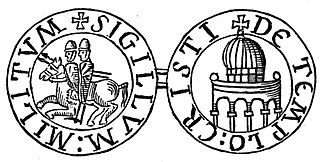
The Poor Fellow-Soldiers of Christ and of the Temple of Solomon, mainly known as the Knights Templar, was a military order of the Catholic faith, and one of the wealthiest and most popular military orders in Western Christianity. They were founded c. 1119, headquartered on the Temple Mount in Jerusalem, and existed for nearly two centuries during the Middle Ages.

Temple is a station on Paris Métro Line 3, located in the 3rd arrondissement of Paris.
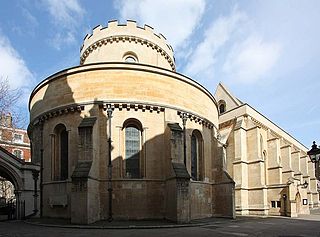
The Temple Church, a royal peculiar in the Church of England, is a church in the City of London located between Fleet Street and the River Thames, built by the Knights Templar for their English headquarters in the Temple precinct. It was consecrated on 10 February 1185 by Patriarch Heraclius of Jerusalem. During the reign of King John (1199–1216) it served as the royal treasury, supported by the role of the Knights Templar as proto-international bankers. It is now jointly owned by the Inner Temple and Middle Temple Inns of Court, bases of the English legal profession. It is famous for being a round church, a common design feature for Knights Templar churches, and for its 13th- and 14th-century stone effigies. It was heavily damaged by German bombing during World War II and has since been greatly restored and rebuilt.

New Haven Coliseum was a sports and entertainment arena located in downtown New Haven, Connecticut. Construction began in 1968 and was completed in 1972. The Coliseum was officially closed on September 1, 2002, by Mayor John DeStefano Jr., and demolished by implosion on January 20, 2007.

The Jussieu Campus is a higher education campus located in the 5th arrondissement of Paris, France. It is the main campus of the Faculty of Science of Sorbonne University. Paris-VII University, was also originally located on the Jussieu campus, but moved to a new, independent campus, Campus des Grands Moulins, in the new Paris Rive Gauche neighbourhood in 2006-2012.
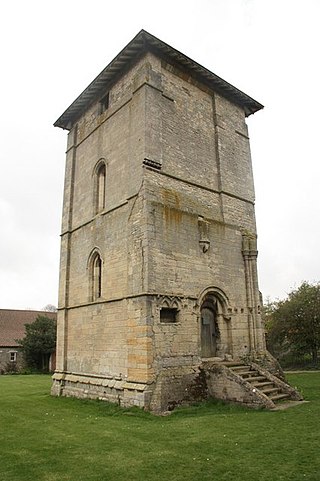
Temple Bruer Preceptory is a historic building in the civil parish of Temple Bruer with Temple High Grange, North Kesteven, Lincolnshire, England. It is one of the few Knights Templar sites left in England where any ruins remain standing. Its name comes from its Templar ownership and its position in the middle of the Lincoln Heath, bruyère (heather) from the French language current at the time. It was founded in the period 1150 to 1160 and the order was dissolved in 1312. The site is located between the A15 and A607 roads, 2.5 miles (4.0 km) north from Cranwell. The site has been excavated twice, firstly by the Rev Dr. G. Oliver, the rector of Scopwick in 1832–3, and in 1908 by Sir William St John Hope.

Rothley Temple, or more correctly Rothley Preceptory, was a preceptory in the village of Rothley, Leicestershire, England, associated with both the Knights Templar and the Knights Hospitaller.
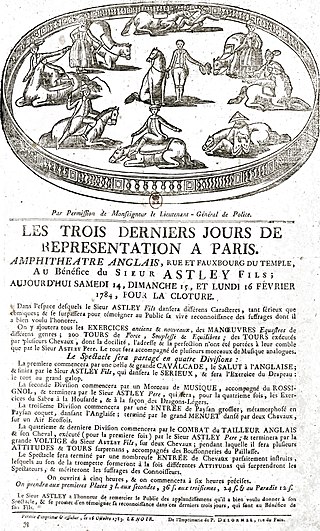
The Cirque Olympique in Paris, also known as the Cirque Franconi, was an equestrian theatre company, founded in 1782 by Philip Astley, the English inventor of the modern circus ring, and was initially known as the Cirque d'Astley or the Cirque Anglais.

The Square du Temple is a garden in Paris, France in the 3rd arrondissement, established in 1857. It is one of 24 city squares planned and created by Georges-Eugène Haussmann and Jean-Charles Adolphe Alphand. The Square occupies the site of a medieval fortress in Paris, built by the Knights Templar. Parts of the fortress were later used as a prison during the French Revolution, and then demolished by the mid-19th century.
Temple Mills is a district located on the boundary of the London boroughs of Newham and Waltham Forest, with a small part also in Hackney in east London.
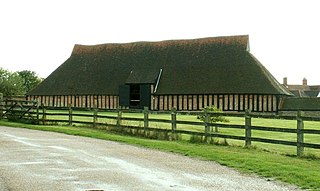
Cressing Temple is a medieval site situated between Witham and Braintree in Essex, close to the villages of Cressing and White Notley. It was amongst the very earliest and largest of the possessions of the Knights Templar in England, and is currently open to the public as a visitor attraction.
Martineau Galleries is a proposed mixed-use development for Birmingham, England which was shelved in 2009 but re-approved in 2020. It was to connect the Eastside to the city centre core, a major retail area.

The Detroit Masonic Temple is the world's largest Masonic Temple. Located in the Cass Corridor of Detroit, Michigan, at 500 Temple Street, the building serves as a home to various masonic organizations including the York Rite Sovereign College of North America. The building contains a variety of public spaces including three theaters, three ballrooms and banquet halls, and a 160 by 100 feet clear-span drill hall.

The Maccabees Building is a historic building located at 5057 Woodward Avenue in Midtown Detroit, Michigan. It was listed on the National Register of Historic Places in 1983, and is currently owned by Wayne State University.

Domme is a commune in the Dordogne department in Nouvelle-Aquitaine in southwestern France. It is sometimes called the "Acropolis of the Périgord".
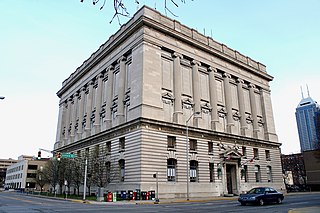
The current Indianapolis Masonic Temple, also known as Indiana Freemasons Hall, is a historic Masonic Temple located at Indianapolis, Indiana. Construction was begun in 1908, and the building was dedicated in May 1909. It is an eight-story, Classical Revival style cubic form building faced in Indiana limestone. The building features rows of engaged Ionic order columns. It was jointly financed by the Indianapolis Masonic Temple Association and the Grand Lodge of Free and Accepted Masons of Indiana, and was designed by the distinguished Indianapolis architectural firm of Rubush and Hunter.

La Gaîté Lyrique is a digital arts and modern music centre opened by the City of Paris in December 2010, located at 3-5 rue Papin in the 3rd arrondissement.
The history of the Knights Templar in England began when the French nobleman Hugues de Payens, founder and Grand Master of the Order, visited the country in 1128 to raise men and money for the Crusades.

Temple Manor is a scheduled ancient monument and grade I listed building in Strood, Kent. The Manor has been owned by various religious, national and farming owners over 600 years. The building has been added to and adapted over the centuries, but the basic structure is now clearly visible.

Parc Georges-Brassens is a public park located in the 15th arrondissement of Paris, between rue des Morillons and rue de Périchaux. Opened in 1984, it occupies 7.74 hectares on the site of a former fish market, horse market and slaughterhouse, and preserves some of the old market structures. It is named for the French popular singer Georges Brassens (1921–1981) who lived in the neighborhood of the park at 9 impasse Florimont and 42 rue Santos Dumont. The nearest metro stations to the park are Convention and Porte-de-Vanves.

















